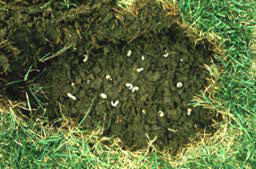Grub is a generic name for the larva of several species of beetles, including Japanese beetles, June bugs and masked chafer beetles. They all look pretty much alike and their life cycles are similar, too.
The beetles lay eggs on blades of grass or in the soil. The eggs hatch and the larvae work their way into the soil, where they dine on organic matter, such as grass roots, for one or more years, depending on the beetle species. Eventually, the larvae pupate and transform into adult beetles, which take flight in early summer to start the process over again.
 Treat the lawn if you find six or more grubs per square foot.
Treat the lawn if you find six or more grubs per square foot.
Photo: Ohio State University
The beetles’ life cycle holds the key to controlling these lawn pests. That makes timing critical when it comes to applying pesticides. The time to treat the lawn with a product to get rid of the root-chewing insects is from mid-June to early July. You will know to treat your lawn if you find six or more grubs per square foot in your lawn. Remember, when applying these products, always read and follow label directions.
Grub control products also kill other turf-damaging insects, such as sod webworms and armyworms. Of course, the best defense against a grub infestation is a healthy, vigorous, well-watered lawn. A healthy lawn can withstand minor grub infestations without any symptoms. For more information about the kinds of grubs that might attack your lawn and recommended pesticide application times, check with your county extension agent.